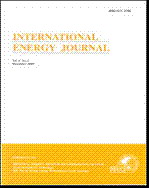ThaiScience
ThaiScience
INTERNATIONAL ENERGY JOURNAL
Volume 21, No. 01, Month MARCH, Year 2021, Pages 183 - 192
Leveraging on repowering of wind sites for potential wind-solar hybrid capacities: a case study
Hirwe Rahul Rajaram, Krishnan B., Balamurugan Guru
Abstract Download PDF
Renewable capacities are eco-friendly and are being welcomed globally. Suitable framework helps in deployment of renewable capacities at good pace. In India, wind development started in early 80’s and is well evolved today. The early wind generators were of kW series, ratings ranging from 200 kW to 800 kW. Many initially set up wind turbines are completing 30 years of operational life span. In India, repowering policy is being implemented to scale up the site capacity and to enhance generation. This paper intends to draw attention of researchers, policy and decision makers on repowering of sites and its utility from solar perspective. Developing wind-solar capacities together has a unique advantage of using of common resources optimally like, land, technical manpower and power evacuation infrastructure. At Kayathar, the National Institute of Wind Energy has wind turbine test bed with old wind turbines. Study is conducted by removal of old make turbines with that of modern turbines and using the set free area for solar installations. On comparing 40.86% more PLF is generated by 4 MW new turbines and 18 MW hybrid capacity produces ~17 times more energy from same site. The total GHG mitigated by the hybrid capacity is 27878.04 tonne of CO2 annually.
Keywords
Hybrid power, Plant load factor, Repowering, Solar power, Wind powerINTERNATIONAL ENERGY JOURNAL
Published by : Asian Institute of Technology
Contributions welcome at : http://www.rericjournal.ait.ac.th
